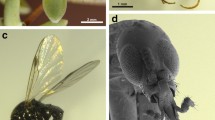Abstract
Nuphar (Nymphaeaceae) comprises a small holarctic group of aquatic perennials whose flowers are pollinated by flies, bees, and beetles. We studied pollination in different populations of the two European speciesN. lutea andN. pumila in Norway and in Germany. Flowers are self-compatible and protogynous, preventing automatic selfing, and insect pollination is required for seed production. Sympatric populations were studied in Vest-Agder county in Norway to determine whetherN. lutea andN. pumila have the same or different pollinators. Allopatric populations ofN. lutea in Germany and Norway were then compared to determine whether their pollinator spectra differ as would be expected in an open flower with seemingly easily accessible pollen and nectar. Results of the present as well as previous studies of the pollination ofN. lutea andN. pumila show that both species are mainly pollinated by flies, including apparentNuphar specialists, such as the scatophagidHydromyza livens and the ephydridsHydrellia andNotiphila, the last also a long-known pollinator ofN. advena in Florida. Pollinator overlap between sympatric heterospecific populations was small, while allopatric conspecific populations had similar visitor and pollinator spectra. We found no evidence of pollination byDonacia beetles as reported from some North American populations ofNuphar.
Similar content being viewed by others
References
Askevold, I., 1988: The genusNeohaemonia Székessy in North America (Coleoptera: Chrysomelidae: Donaciinae): systematics, reconstructed phylogeny, and geographic history.—Trans. Amer. Entomol. Soc.113: 360–430.
, 1990: Classification of Tertiary fossilDonaciinae of North America and their implications about evolution ofDonaciinae (Coleoptera: Chrysomelidae).—Canad. J. Zool.68: 2135–2145.
, 1991: Classification, reconstructed phylogeny, and geographic history of the New World members ofPlateumaris Thomson, 1859 (Coleoptera: Chrysomelidae: Donaciinae)—Mem. Entomol. Soc. Canada157: 5–175.
Beal, E. O., 1956: Taxonomic revision of the genusNuphar Sm. of North America and Europe. — J. Elisha Mitchell Sci. Soc.72: 317–346.
Brock, T. C. M., van der Velde, G., 1983: An autecological study onHydromyza livens (Fabricius) (Diptera, Scatomyzidae) a fly associated with nymphaeid vegetation dominated byNuphar. — Tijdschr. Entomol126: 59–90.
Cook, C. D. K., 1990: Aquatic plant book.— The Hague: SPB Academic Publishing.
Crowson, R. A., 1981: The biology of theColeoptera.—London: Academic Press.
Cruden, R. W., 1977: Pollen-ovule ratios: a conservative indicator of breeding systems in flowering plants. — Evolution31: 32–46.
Ervik, F., Renner, S., Johanson, K. A., 1995: Breeding system and pollination ofNuphar lutea (L.)Smith (Nymphaeaceae) in Norway. — Flora190: 109–113.
Giesen, H. G., van der Velde, G., 1983: Ultraviolet reflectance and absorption patterns in flowers ofNymphaea alba L.,Nymphaea candida Presl andNuphar lutea (L.)Sm. (Nymphaeaceae).— Aquatic Bot.16: 369–376.
Heslop-Harrison, Y., 1955: Biological flora of the British Isles:Nuphar Sm.— J. Ecol.43: 342–364.
Knuth, P., 1898: Handbuch der Blütenbiologie.II. — Leipzig: Engelmann.
Les, D. H., Garvin, D. K., Wimpee, C. F., 1991: Molecular evolutionary history of ancient aquatic angiosperms. — Proc. Natl. Acad. Sci. USA88: 10119–10123.
Lippok, B., 1995: Bestäuberspektrum und Reproduktionssystem der Gelben Teichrose (Nuphar lutea ssp.lutea (L.)Sm.) in den Rheinkribben bei Bingen. — M.Sc. Thesis, University of Mainz, Germany.
Meusel, H., Mühlberg, H., 1965:Nymphaeales. — InHegi, G., (Ed.): Flora von Mitteleuropa,3, pp. 20–26. 2nd edn. — München: Hanser.
Robertson, C., 1889: Flowers and insectsI. — Bot. Gaz.14: 122–123.
Schneider, E. L., 1979: Pollination biology of theNymphaeaceae.—Proceedings of the IVth International Symposium on Pollination, Maryland Agri.— Exp. Station Special Misc. Publ.1: 419–429.
, 1977: Morphological studies of theNymphaeaceae. VII: The floral biology ofNuphar lutea ssp.macrophylla. — Brittonia29: 88–99.
, 1993:Nymphaeaceae. — InKubitzki, K., Rohwer, J. G., Bittrich, V., (Eds): The families and genera of vascular plants,2, pp. 486–493. — Berlin, Heidelberg, New York: Springer.
Sprengel, C. K., 1793: Das entdeckte Geheimnis der Natur im Bau und in der Befruchtung der Blumen. — Berlin: Vieweg.
Stace, C., 1991: New flora of the British Isles. — New York: Cambridge University Press.
van der Velde, G., 1986: Developmental stages in the floral biology of DutchNymphaeaceae (Nymphaea alba L.,Nymphaea candida Presl,Nuphar lutea (L.)Sm.). — Acta Bot. Neerl.35: 111–113.
, 1978: Flowers of DutchNymphaeaceae as a habitat for insects. — Acta Bot. Neerl.27: 429–430.
Vogel, S., 1990: The role of scent glands in pollination. — Washington: Smithsonian Institution Libraries.
Wiersema, J. H., Hellquist, C. B., 1997:Nymphaeaceae. — In: Flora of North America3. — New York: Oxford University Press (in press).
Williamson, P. S., Schneider, E. L., 1994: Floral aspects ofBarclaya (Nymphaeaceae): pollination, ontogeny and structure. — Pl. Syst. Evol., Suppl.8: 159–173.
Author information
Authors and Affiliations
Additional information
Dedicated to Univ.-Prof. DrF. Ehrendorfer on the occasion of his 70th birthday
Rights and permissions
About this article
Cite this article
Lippok, B., Renner, S.S. Pollination ofNuphar (Nymphaeaceae) in Europe: Flies and bees rather thanDonacia beetles. Pl Syst Evol 207, 273–283 (1997). https://doi.org/10.1007/BF00984392
Received:
Revised:
Accepted:
Issue Date:
DOI: https://doi.org/10.1007/BF00984392




